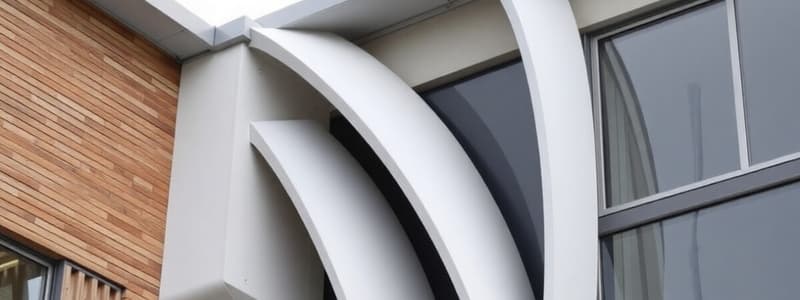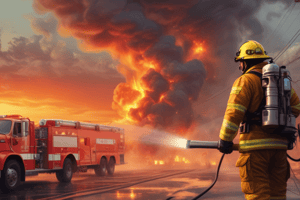Podcast
Questions and Answers
What is the primary function of a wind tower?
What is the primary function of a wind tower?
- To collect rainwater for irrigation
- To provide cooling through air movement (correct)
- To filter air pollutants from the environment
- To generate electricity using wind energy
How does the temperature difference between the interior and exterior contribute to the operation of a wind tower?
How does the temperature difference between the interior and exterior contribute to the operation of a wind tower?
- It ensures that the interior temperature remains constant
- It creates a constant airflow regardless of environmental conditions
- It generates a draft that facilitates air movement through the tower (correct)
- It allows heat to escape entirely without any air movement
What role does nocturnal radiation play in the functioning of a wind tower at night?
What role does nocturnal radiation play in the functioning of a wind tower at night?
- It absorbs the warm air and prevents drafts
- It redistributes heat within the building
- It cools the entire building structure effectively
- It enhances the upward draft by warming the cool night air (correct)
Under what circumstances might wind towers need to be shut off?
Under what circumstances might wind towers need to be shut off?
What is a significant characteristic of wind towers that influences their efficiency?
What is a significant characteristic of wind towers that influences their efficiency?
What is the minimum recommended distance for cross ventilation between buildings of equal height?
What is the minimum recommended distance for cross ventilation between buildings of equal height?
Which factor affects the calculation of stack pressure according to the given equation?
Which factor affects the calculation of stack pressure according to the given equation?
What happens to the air in a solar chimney during the day?
What happens to the air in a solar chimney during the day?
How can high-density layouts affect cross ventilation?
How can high-density layouts affect cross ventilation?
Which of the following variables is part of the stack pressure equation?
Which of the following variables is part of the stack pressure equation?
What occurs during the night in a solar chimney system?
What occurs during the night in a solar chimney system?
What does the constant 0.042 represent in the stack pressure equation?
What does the constant 0.042 represent in the stack pressure equation?
What is a potential solution to overcome reduced cross ventilation in dense urban environments?
What is a potential solution to overcome reduced cross ventilation in dense urban environments?
What effect does a gap between the building face and canopy have on airflow?
What effect does a gap between the building face and canopy have on airflow?
In terms of ventilation, what is cross-ventilation?
In terms of ventilation, what is cross-ventilation?
What is the result of placing openings directly across from each other in a building?
What is the result of placing openings directly across from each other in a building?
What is often true regarding the optimum orientation for solar gain and wind?
What is often true regarding the optimum orientation for solar gain and wind?
Why is it generally recommended to avoid placing openings directly across from each other?
Why is it generally recommended to avoid placing openings directly across from each other?
What happens to airflow in a building with a windward opening but no outlet?
What happens to airflow in a building with a windward opening but no outlet?
What is the primary reason for creating a broader wind shadow?
What is the primary reason for creating a broader wind shadow?
What orientation is preferable for sun exclusion in equatorial regions?
What orientation is preferable for sun exclusion in equatorial regions?
What effect does the presence of wind have on the operation of a wind tower?
What effect does the presence of wind have on the operation of a wind tower?
What happens to the hot ambient air when it comes into contact with the cool upper part of the tower?
What happens to the hot ambient air when it comes into contact with the cool upper part of the tower?
Which scenario can negatively impact the effectiveness of a wind tower?
Which scenario can negatively impact the effectiveness of a wind tower?
What effect does nocturnal radiation have in the context of a wind tower?
What effect does nocturnal radiation have in the context of a wind tower?
What is a prerequisite for the effective operation of a wind catcher?
What is a prerequisite for the effective operation of a wind catcher?
What happens to the tower's operation in the absence of wind?
What happens to the tower's operation in the absence of wind?
Where is the cooling effect from a wind tower most effective?
Where is the cooling effect from a wind tower most effective?
How does the ambient air temperature affect the performance of a wind tower?
How does the ambient air temperature affect the performance of a wind tower?
What happens to indoor air velocity when openings are placed at right angles to the wind direction?
What happens to indoor air velocity when openings are placed at right angles to the wind direction?
How does a wind incidence of 45° affect pressure and average indoor air velocity?
How does a wind incidence of 45° affect pressure and average indoor air velocity?
What can be done to improve air flow around internal obstacles like walls or furniture?
What can be done to improve air flow around internal obstacles like walls or furniture?
What is the primary goal when placing inlets and outlets in a building?
What is the primary goal when placing inlets and outlets in a building?
How can cross ventilation be increased in a building?
How can cross ventilation be increased in a building?
What effect do right-angle bends in airflow have on low velocity air flow?
What effect do right-angle bends in airflow have on low velocity air flow?
What is a benefit of having larger openings on the leeward faces of a building?
What is a benefit of having larger openings on the leeward faces of a building?
What can be a consequence of having well-cooled areas in a room?
What can be a consequence of having well-cooled areas in a room?
Flashcards are hidden until you start studying
Study Notes
Stack Effect
- The stack effect is a natural process where warmer air rises and cooler air descends, creating air movement in enclosed spaces.
- Stack effect can be used for ventilation, particularly in buildings with chimneys, courtyards, and wind towers.
- Stack pressure (Ps) can be calculated using the formula: Ps = 0.042 × h × ΔT where:
- Ps is the stack pressure in N/m2
- h is the height of the stack in meters
- ΔT is the temperature difference in degrees Celsius
Applications of Stack Effect
- Chimneys: Heated air rises through the chimney, creating negative pressure inside the building, drawing in cooler air.
- Courtyards: During the day, solar radiation heats the courtyard air, which rises, drawing cooler outdoor air into the spaces.
- Wind Towers: In windy conditions, cool night air is drawn into the tower and then forced downwards into living spaces.
- Wind Tower Operation:
- Day: Hot ambient air cools when it contacts the cool upper part of the tower, becomes denser, sinks, and replaces hot air in the living spaces.
- Night: The tower walls absorb heat during the day and release it at night, warming the cool night air.
- Wind Tower Considerations:
- Wind towers may need to be shut off when cooling is not required.
- Wind towers are typically used in hot and dry climates for cooling purposes.
Wind Shadow and Wind Towers
- Buildings can create wind shadows that affect ventilation.
- The wind shadow created by a building can be reduced by using a gap between the building face and the canopy.
- This gap creates a downward pressure, directing airflow into the living zone.
- Wind towers are commonly used to improve ventilation in low-rise, high-density settlements where wind access is limited.
- Wind towers capture wind above the building and draw it downwards, delivering fresh air.
- The orientation and position of louvers can significantly affect the indoor airflow and the wind shadow.
Cross-Ventilation
- Cross-ventilation optimizes airflow by placing openings strategically to guide air through a building.
- Optimal cross-ventilation is achieved with openings placed on opposite sides of a building.
- To ensure effective air movement, avoid placing openings directly opposite each other.
- Larger openings on the leeward faces of the building compared to the windward faces enhance cross-ventilation.
- Placement of inlets at high-pressure zones and outlet at low-pressure zones improves airflow.
- Obstacles like internal walls and furniture can reduce the speed of airflow through cross-ventilation.
- Partition screens can be used to maintain some airflow even when internal partitions are necessary.
Orientation and Wind Direction
- Buildings oriented at right angles to the wind direction experience the highest pressure and airflow.
- A 45-degree wind incidence reduces pressure by 50% but increases the average indoor air velocity.
- It is important to consider the wind direction and optimize the building's orientation for both wind and solar gains.
- In equatorial regions, a building's north-south orientation is generally preferable for solar exclusion, but often the wind is predominantly easterly.
Studying That Suits You
Use AI to generate personalized quizzes and flashcards to suit your learning preferences.




